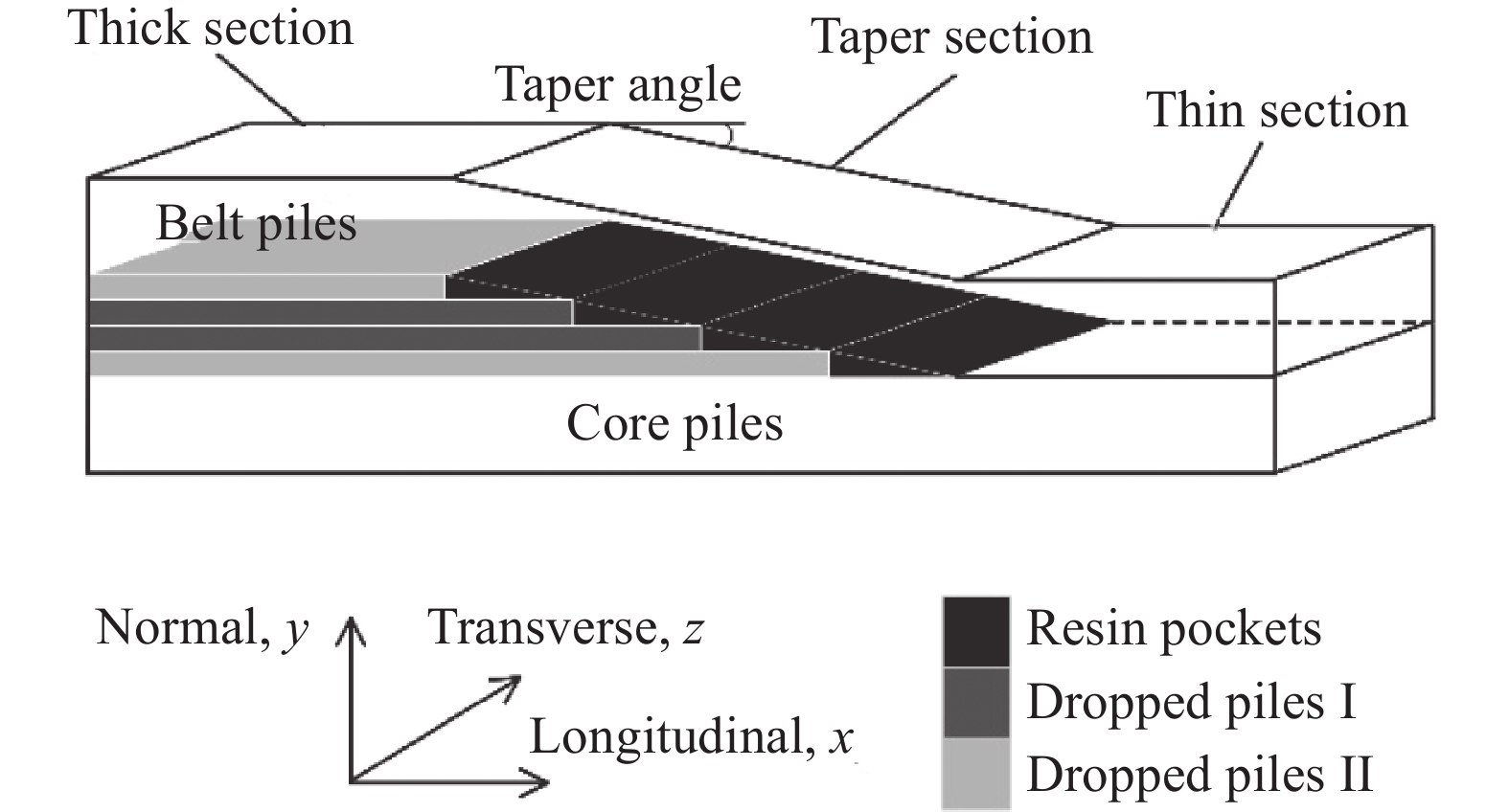Numerical simulation and influence factors analysis of cure-induced distortions in resin matrix composites with variable thickness
-
摘要: 通过层间丢层形成的变厚度树脂基复合材料构件具有减材减重、可刚性裁剪等优点,常应用于机翼结构等重要位置。但层间丢层会导致构件内部的不连续性,并使构件在固化后产生不均匀残余应力,脱模后发生复杂固化变形。针对变厚度复合材料构件的固化变形预测问题,现有研究多采用等效材料性能参数的建模方法,尚未考虑其树脂口袋等结构特点。本文基于分层建模方法,在丢层位置引入树脂口袋结构,建立了变厚度构件固化变形数值仿真模型。通过与传统等效建模方法、传统分层建模方法及实验的结果比较,本文模型最大翘曲变形模拟值的误差与实验值误差仅为1.01×10−2 mm,且变形趋势一致,验证了模型的有效性和准确性。并分析了不同丢层方式、过渡区斜率、厚薄比对变厚度构件固化变形的影响规律,其中离散丢层的构件变形最小,重叠丢层的构件变形最大,且增加过渡区斜率和降低厚薄比可以有效降低其翘曲变形。Abstract: The carbon fiber reinforced polymer (CFRP) composite parts with variable thickness possessed the advantages of material saving, weight reduction, and elastic tailoring properties, and were often used in important application such as wing structures. However, dropping-off plies between layers caused a discontinuity inside the part. Therefore, uneven residual stress could be generated after the curing, and the complex cure-induced distortion (CID) appeared after demolding. For the prediction of the CID of CFRP parts with variable thickness, the existing research mainly adopted the modeling method of equivalent material parameters, without considering the structural characteristics of the resin pocket. In this paper, based on the laminated modeling method, the resin pocket structure was introduced at the dropping-off plies position, and the numerical simulation model of the CID was established. Compared with the results of the traditional equivalent modeling method, the traditional laminated modeling method and experiment, it is proved that the proposed model has the preferable accuracy, the error of the simulated CID is only 1.01×10−2 mm compared with the experimental result, and the deformation trend is consistent. The influence of different ply drop-off patterns, taper section slopes, and thickness-to-thin ratios on the CID was analyzed. The part with a dispersed ply drop-off pattern presents the smallest CID, and the part with the overlapped ply drop-off pattern has the largest CID. Increasing the taper section slope and reducing the thickness ratio can effectively reduce the warpage.
-
Key words:
- composite /
- variable thickness /
- cure-induced deformation /
- residual stress /
- numerical simulation
-
表 1 T800 HB碳纤维/3900-2环氧树脂复合材料的热学性能[16]
Table 1. Thermal properties of T800 HB carbon fiber/3900-2 epoxy composite[16]
Constant Value ρ/(kg·m−3) 1600 ρr/(kg·m−3) 1380 C/(J·kg−1·K−1) 925 kx/(W·m−1·K−1) 7·61 ky=kz/(W·m−1·K−1) 0.90 Vf/vol% 62.5 HR/(kJ·kg−1) 246 Notes: ρ—Composite density; ρr—Resin density; C—Specific heat capacity; kx, ky and kz—Longitudinal , normal and transverse thermal conductivity coefficient, respectively; HR—Total amount of heat; Vf—Average fiber volume fraction. Constant Value A/s–1 1.933×105 ∆E/(J∙mol–1) 7.25×104 m 0.1781 n 1.2323 R/(J∙mol–1∙K–1) 8.314 Notes: A—Frequency factor of autocatalytic model; ∆E— Activation energy of autocatalytic model; m, n—Reaction constant; R—Perfect gas constant. 表 3 T800 HB/3900-2单向复合材料的材料参数[16]
Table 3. Material parameters of T800 HB/3900-2 unidirectional composites[16]
Parameter Viscous Rubbery Glassy E1/MPa 169000 169000 169000 E2=E3/MPa 0.272 272.133 8620 G12=G13/MPa 0.068 68.033 5000 G23/MPa 0.068 68.033 1220 ν12=ν13 0.5 0.5 0.355 ν23 0.995 0.995 0.41 β1/(10−6 ℃−1) — — 0 β2=β3/(10−6 ℃−1) — — 29.5 γ1/% 0 0 — γ2=γ3/% -0.19 −0.18 — Notes: E1, E2, E3—Elastic modulus of composite; G12, G13, G23—Shear modulus of composite; ν12 , ν13, ν23—Poisson's ratio of composite; β1, β2, β3—Coefficient of thermal expansion (CTE) of composite; γ1, γ2, γ3—Chemical shrinkage coefficient of composite. 表 4 3900-2树脂的材料参数
Table 4. Material parameters of 3900-2 resin
Parameter Value Er/MPa 0.0471 (Viscous) [16] 47.1 (Rubbery) [16] 4710 (Glassy) [16] Gr/MPa 0.0157 (Viscous) 15.7 (Rubbery) 1744.4 (Glassy) νr 0.5 (Viscous & Rubbery)[16,33] 0.35 (Glassy) [35] βre/(10−6 ℃−1) 80[36] γre/% −0.99[36] Notes: Er—Elastic modulus of the resin; βre—CTE of the resin; γre—Chemical shrinkage coefficient of the resin. Plane BC1 BC2 BC3 BC4 BC5 X=0 S S S RX/RY S X =L DX S S RX/DY TX Y=0 S S S F S Y=W S DY S F TY Z=0 S S S S S Z=H S S DZ S TZ Notes: D denotes to apply a uniform displacement to the plane; S denotes to apply a symmetrical constraint to the plane; R denotes to limit the displacement of the plane; F denotes that no constraints are imposed; T denotes that the plane is coupled to the other parallel plane, ensuring that all nodes in these two planes move in the same direction. 表 6 [45/−45/90/0]nS铺层T800 HB/3900-2复合材料等效性能
Table 6. Equivalent material properties of T800 HB/3900-2 composites with [45/−45/90/0]nS layup
Parameter Viscous Rubbery Glassy E1=E2/MPa 44896 45906 60408 E3/MPa 18.44 12557 10116 G12/MPa 2730.4 4887.5 18347.8 G13=G23/MPa 0.068 68.033 2157.1 ν12 5.92×10−5 0.029 0.195 ν13=ν23 0.995 0.968 0.362 β1=β2/(10−6 ℃−1) — — 0.773 β3/(10−6 ℃−1) — — 11.765 γ1=γ2/% −0.00013 −0.133 — γ3/% −0.37 −0.36 — 表 7 变厚度T800 HB/3900-2复合材料构件编号和丢层方式
Table 7. IDs and ply drop-off patterns of tapered T800 HB/3900-2 composite part
Part ID Ply drop-off pattern A Staircased (nD=1) B Overlapped (nD=1) C Staircased (nD=2) D Overlapped (nD=2) E Dispersed I (nD=1) F Dispersed II (nD=1) -
[1] 顾轶卓, 张佐光, 李敏, 等. 复合材料变厚层板热压成型缺陷类型与成因实验研究[J]. 复合材料学报, 2008, 25(2):41-46. doi: 10.3321/j.issn:1000-3851.2008.02.008GU Yizhuo, ZHANG Zuoguang, LI Min, et al. Experimental study on type and cause of defects in variable thickness composite laminates during hot pressing process[J]. Acta Materiae Compositae Sinica,2008,25(2):41-46(in Chinese). doi: 10.3321/j.issn:1000-3851.2008.02.008 [2] 马晓东, 孙志杰, 顾轶卓, 等. 变厚度复合材料热压罐工艺层板厚度控制的实验研究[J]. 复合材料学报, 2009, 26(5):14-19. doi: 10.3321/j.issn:1000-3851.2009.05.003MA Xiaodong, SUN Zhijie, GU Yizhuo, et al. Experimental analysis on thickness control of variable thickness composite laminates during autoclave process[J]. Acta Materiae Compositae Sinica,2009,26(5):14-19(in Chinese). doi: 10.3321/j.issn:1000-3851.2009.05.003 [3] 邵小军, 岳珠峰, 刘永寿. 对称削层复合材料结构的有限元分析[J]. 强度与环境, 2006, 33(1):9-13. doi: 10.3969/j.issn.1006-3919.2006.01.002SHAO Xiaojun, YUE Zhufeng, LIU Yongshou. FEM analysis of symmetrical composite structure with ply drop-off[J]. Structure & Environment Engineering,2006,33(1):9-13(in Chinese). doi: 10.3969/j.issn.1006-3919.2006.01.002 [4] 周梦倩, 王华. 变厚度复合材料C梁数值模拟与实验[J]. 机械设计与研究, 2019, 35(3):80-82.ZHOU Mengqian, WANG Hua. Numerical simulation and experiment study of variable thickness composite C beam[J]. Machine Design and Research,2019,35(3):80-82(in Chinese). [5] HE K, HOA S V, GANESAN R. The study of tapered laminated composite structures: A review[J]. Composites Science and Technology,2000,60(14):2643-2657. doi: 10.1016/S0266-3538(00)00138-X [6] MUKHERJEE A, VARUGHESE B. Design guidelines for ply drop-off in laminated composite structures[J]. Composites Part B: Engineering,2001,32(2):153-164. doi: 10.1016/S1359-8368(00)00038-X [7] 戴福洪, 张博明, 杜善义. 复合材料非对称正交薄层板的固化变形[J]. 复合材料学报, 2006, 23(4):164-168. doi: 10.3321/j.issn:1000-3851.2006.04.028DAI Fuhong, ZHANG Boming, DU Shanyi. Cured shape of cross-ply thin unsymmetrical composite laminates[J]. Acta Materiae Compositae Sinica,2006,23(4):164-168(in Chinese). doi: 10.3321/j.issn:1000-3851.2006.04.028 [8] 元振毅, 王永军, 王俊彪, 等. 基于模具-制件相互作用的复合材料制件固化变形数值模型[J]. 复合材料学报, 2016, 33(4):902-909.YUAN Zhenyi, WANG Yongjun, WANG Junbiao, et al. Numerical model on curing deformation of composite part based on tool-part interaction[J]. Acta Materiae Compositae Sinica,2016,33(4):902-909(in Chinese). [9] LUO L, ZHANG B, ZHANG G, et al. Rapid prediction of cured shape types of composite laminates using a FEM-ANN method[J]. Composite Structures,2020,238(2):111980. [10] 晏冬秀. 碳纤维复合材料C型梁制造变形预测与控制[D]. 上海: 上海交通大学, 2016.YAN Dongxiu. Prediction and control of the CFRP C-spar deformation during manufacturing[D]. Shanghai: Shanghai Jiao Tong University, 2016 (in Chinese). [11] 丁安心, 王继辉, 倪爱清, 等. 热固性树脂基复合材料固化变形解析预测研究进展[J]. 复合材料学报, 2018, 35(6):1361-1376.DING Anxin, WANG Jihui, NI Aiqing, et al. A review of analytical prediction of cure induced distortions in thermoset composites[J]. Acta Materiae Compositae Sinica,2018,35(6):1361-1376(in Chinese). [12] WUCHER B, LANI F, PARDOEN T, et al. Tooling geometry optimization for compensation of cure-induced distortions of a curved carbon/epoxy C-spar[J]. Composites Part A: Applied Science and Manufacturing,2014,56:27-35. doi: 10.1016/j.compositesa.2013.09.010 [13] 丁安心, 李书欣, 倪爱清, 等. 热固性树脂基复合材料固化变形和残余应力数值模拟研究综述[J]. 复合材料学报, 2017, 34(3):471-485.DING Anxin, LI Shuxin, NI Aiqing, et al. A review of numerical simulation of cure-induced distortions and residual stresses in thermoset composites[J]. Acta Materiae Compositae Sinica,2017,34(3):471-485(in Chinese). [14] 闵荣, 元振毅, 王永军, 等. 基于黏弹性本构模型的热固性树脂基复合材料固化变形数值仿真模型[J]. 复合材料学报, 2017, 34(10):2254-2262.MIN Rong, YUAN Zhenyi, WANG Yongjun, et al. Numerical simulation for curing deformation of matrix thermosetting composite using viscoelastic constitutive model[J]. Acta Materiae Compositae Sinica,2017,34(10):2254-2262(in Chinese). [15] YUAN Z, WANG Y, PENG X, et al. An analytical model on through-thickness stresses and warpage of composite laminates due to tool-part interaction[J]. Composites Part B: Engineering,2016,91:408-413. doi: 10.1016/j.compositesb.2016.01.016 [16] QIAO W, YAO W. Modelling of process-induced deformation for composite parts considering tool-part interaction[J]. Materials,2020,13(20):4503. doi: 10.3390/ma13204503 [17] 乔巍, 姚卫星, 黄杰. 考虑模具和黏弹性的复合材料固化变形数值模型[J]. 复合材料科学与工程, 2020(10):67-74. doi: 10.3969/j.issn.1003-0999.2020.10.009QIAO Wei, YAO Weixing, HUANG Jie. Numerical model of process-induced deformation in composite parts considering mould and material viscoelasticity[J]. Composites Science and Engineering,2020(10):67-74(in Chinese). doi: 10.3969/j.issn.1003-0999.2020.10.009 [18] 王乾, 关志东, 蒋婷, 等. 纤维体积含量和富树脂对复合材料V型结构固化变形的影响[J]. 复合材料学报, 2018, 35(3):580-590.WANG Qian, GUAN Zhidong, JIANG Ting, et al. Influence of fiber volume content and resin-rich area on process distortions of V-shaped composite parts[J]. Acta Materiae Compositae Sinica,2018,35(3):580-590(in Chinese). [19] WISNOM M R, POTTER K D, ERSOY N. Shear-lag analysis of the effect of thickness on spring-in of curved composites[J]. Journal of Composite Materials,2007,41(11):1311-1324. doi: 10.1177/0021998306068072 [20] ERSOY N, GARSTKA T, POTTER K, et al. Modelling of the spring-in phenomenon in curved parts made of a thermosetting composite[J]. Composites Part A: Applied Science and Manufacturing,2010,41(3):410-418. doi: 10.1016/j.compositesa.2009.11.008 [21] 丁安心. 热固性树脂基复合材料固化变形数值模拟和理论研究[D]. 武汉: 武汉理工大学, 2016.DING Anxin. Numerical and theoretical study on process-induced distortions in thermoset composites[D]. Wuhan: Wuhan University of Technology, 2016(in Chinese). [22] 孙立帅, 刘闯, 李玉军, 等. 变厚度复合材料U型零件固化变形仿真预测与结构影响因素[J]. 复合材料学报, 2023, 40(1):553-566. doi: 10.13801/j.cnki.fhclxb.20220126.001SUN Lishuai, LIU Chuang, LI Yujun, et al. Prediction and analysis of cure-induced deformation of composite U-shaped parts with variable thickness[J]. Acta Materiae Compositae Sinica,2023,40(1):553-566(in Chinese). doi: 10.13801/j.cnki.fhclxb.20220126.001 [23] TROFIMOV A, LE-PAVIC J, RAVEY C, et al. Multi-scale modeling of distortion in the non-flat 3D woven composite part manufactured using resin transfer molding[J]. Composites Part A: Applied Science and Manufacturing,2021,140:106145. doi: 10.1016/j.compositesa.2020.106145 [24] TAKAGAKI K, MINAKUCHI S, TAKEDA N. Process-induced strain and distortion in curved composites. Part II: Parametric study and application[J]. Composites Part A: Applied Science and Manufacturing,2017,103:219-229. doi: 10.1016/j.compositesa.2017.09.019 [25] 李树健, 湛利华, 白海明, 等. 基于树脂流动的变截面复合材料结构固化过程热-流-固多场强耦合数值仿真[J]. 复合材料学报, 2018, 35(8):2095-2102.LI Shujian, ZHAN Lihua, BAI Haiming, et al. Numerical simulation of heat-flow-solid multi-field strong coupling in curing process of variable cross-section composite structures based on the resin flow[J]. Acta Materiae Compositae Sinica,2018,35(8):2095-2102(in Chinese). [26] 王振世. 变厚度复合材料构件铺层递减设计[D]. 南京: 南京航空航天大学, 2009.WANG Zhenshi. Design for ply drop-off in composite laminates with variable thickness[D]. Nanjing: Nanjing University of Aeronautics and Astronautics, 2009(in Chinese). [27] OBATA S, TAKAHASHI K, INABA K. Laminate design for a tapered FRP structure with ply drop-off based on yielding of resin pockets[J]. Composite Structures,2020,253:112787. doi: 10.1016/j.compstruct.2020.112787 [28] THAWRE M M, VERMA K K, JAGANNATHAN N, et al. Effect of ply-drop on fatigue life of a carbon fiber composite under a fighter aircraft spectrum load sequence[J]. Composites Part B: Engineering,2016,86:120-125. doi: 10.1016/j.compositesb.2015.10.002 [29] BOGETTI T A, GILLESPIE J W. Two-dimensional cure simulation of thick thermosetting composites[J]. Journal of Composite Materials,1991,25(3):239-273. doi: 10.1177/002199839102500302 [30] LI X Y, WANG J H, LI S X, et al. Cure-induced temperature gradient in laminated composite plate: Numerical simulation and experimental measurement[J]. Composite Structures, 2020, 253: 112822. [31] YOUSEFI A, LAFLEUR P G, GAUVIN R. Kinetic studies of thermoset cure reactions: A review[J]. Polymer Composites,1997,18(2):157-168. doi: 10.1002/pc.10270 [32] JANKOVIC B. Kinetic and reactivity distribution behaviors during curing process of carbon/epoxy composite with thermoplastic interface coatings (T800/3900-2 prepreg) under the nonisothermal conditions[J]. Polymer Composites,2018,39(1):201-220. doi: 10.1002/pc.23920 [33] 乔巍, 姚卫星, 马铭泽. 复合材料残余应力和固化变形数值模拟及本构模型评价[J]. 材料导报, 2019, 33(24):4193-4198. doi: 10.11896/cldb.18110061QIAO Wei, YAO Weixing, MA Mingze. Numerical simulation and constitutive models evaluation of residual stresses and process-induced deformations of composite structures[J]. Materials Reports,2019,33(24):4193-4198(in Chinese). doi: 10.11896/cldb.18110061 [34] MAGNUS SVANBERG J, ANDERS HOLMBERG J. Prediction of shape distortions Part I. FE-implementation of a path dependent constitutive model[J]. Composites Part A: Applied Science and Manufacturing,2004,35(6):711-721. doi: 10.1016/j.compositesa.2004.02.005 [35] DESAEGER M, VERPOEST I. On the use of the micro-indentation test technique to measure the interfacial shear strength of fibre-reinforced polymer composites[J]. Composites Science and Technology,1993,48(1-4):215-226. doi: 10.1016/0266-3538(93)90139-8 [36] ÇINAR K, ÖZTÜRK U E, ERSOY N, et al. Modelling manufacturing deformations in corner sections made of composite materials[J]. Journal of Composite Materials,2014,48(7):799-813. doi: 10.1177/0021998313477896 [37] ZHANG B, KAWASHITA L F, JONES M I, et al. An experimental and numerical investigation into damage mechanisms in tapered laminates under tensile loading[J]. Composites Part A: Applied Science and Manufacturing,2020,133:105862. doi: 10.1016/j.compositesa.2020.105862 -






 下载:
下载:



















